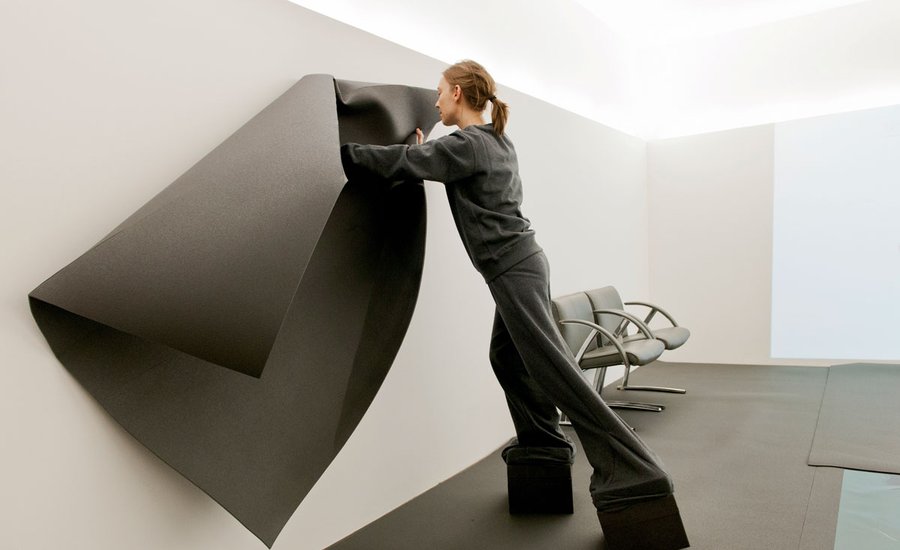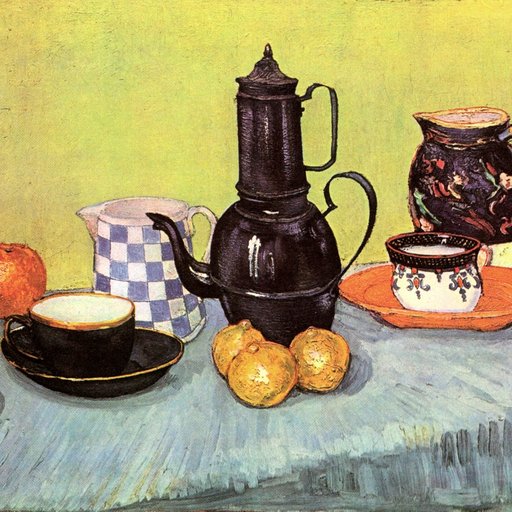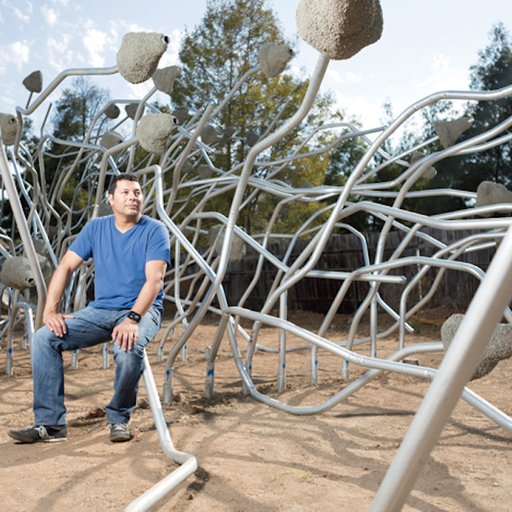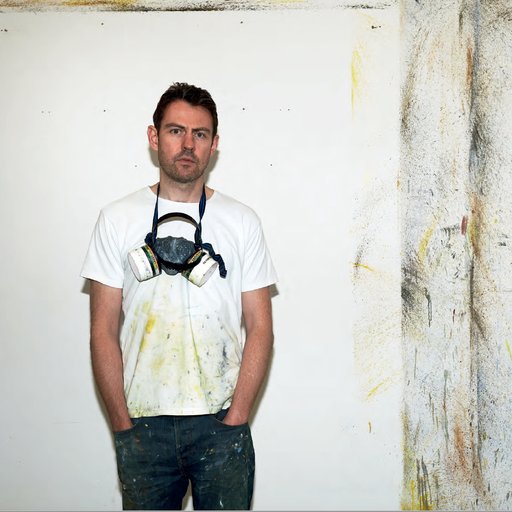Germany has long served as one of the hubs of high culture in central Europe, producing some of the West’s most enduring authors, poets, thinkers, composers, and artists. Even more impressive, it’s managed to retain this reputation through the many wars and cultural upheavals that have rocked the nation (and the world) over the past several centuries. Now, with its extensive network of Kunsthalles, free secondary education, and an informed and sophisticated collector base, Germany is renowned as the home of some of the most progressive, experimental, and, yes, difficult art being made today.
In this excerpt from Phaidon’s Vitamin: 3D , an exhaustive compendium of today’s most important sculptors, we take a closer look at three German women who are currently in the process of redefining the medium for the 21st century. Each solidly in the middle of their careers, these are true artist’s artists that show the range of contemporary sculpture with their incisive work.
KITTY KRAUS
Born 1976 Heidelberg, Germany. Lives in Berlin, Germany.
 Untitled
, 2008
Untitled
, 2008
Kitty Kraus’s fascinating process of reduction in her work creates a sense of unease. At first glance her elemental formal vocabulary, her limited, almost achromatic color range and her prefabricated everyday materials, such as glass, neon tubes, incandescent bulbs, adhesive tape, fabric, tar, ink, and water, evoke the forms and propositions associated with Minimal art or the earlier Constructivist movement. But on closer inspection Kraus’s seemingly orderly, geometrical world is characterized by fragmentation, dissolution, instability, destruction, and loss of control.
Kraus cuts up suits and presents them as rectangles forming architectural islands in the space, as Minimalist floor works, or as areas linking floor and wall. Panes of glass lean at strange angles to each other and to the gallery wall. These are disturbing definitions within the space, balancing at the limits of visibility, addressing viewers directly, and disturbing their uninhibited movement around the gallery. They initiate an interplay between conscious visual perception and subconscious physical orientation.
But Kraus’s objects also remind us of the human body, invoking the tripartite division of head, torso, and legs through the use of geometrical forms. These non-figurative “bodies” are trapped in a potentially threatened and constantly disturbing state of immobility. Evocations of bodies in the absence of the body, disembodiment through the imposition of geometrical form, the creation of boundaries and limits (through space, clothing, the physical nature of materials and the right angle), and the constructions created by this geometry are all central to her work.
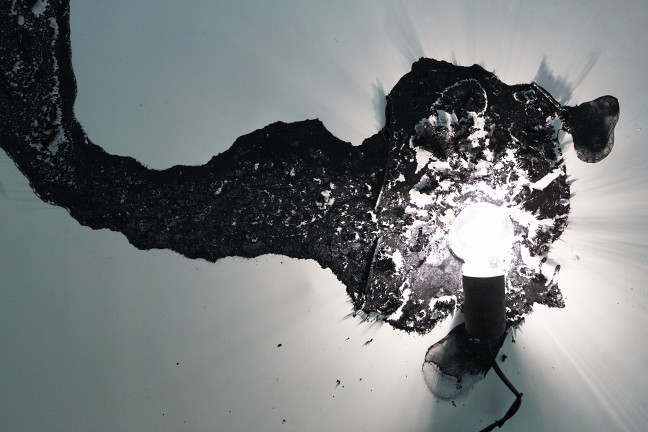 Untitled
, 2006-2011
Untitled
, 2006-2011
In other pieces, Kraus captures the light from a lamp with six mirrors fastened loosely together to form a cube. Beams of light escape into the space through the imperfectly sealed edges—a spectacle that Kraus tries to reconstruct in countless drawings of reflection paths and deviations. But her attempts to perfect are what contradict the uncontrollable nature of hand-made mirror cubes. At one performance event, Kraus heated up a mirror lamp with an incandescent bulb to such an extent that the infinite reflection of nothing vaporized in the space in an uncontrolled explosion.
The relationship between geometrical and organic, controlled and spontaneous form is also addressed in Kraus’s cubes of frozen water colored with ink. These leave a random “painting” on the floor as they melt in the heat of a light bulb frozen inside them. Sometimes Kraus transmits the sound made by the conflicting temperatures inside the ice via a microphone frozen within it.
Kraus’s exhibitions are dramaturgically charged ensembles of encounters between the controlled and uncontrollable presence of bodies. But they are also dramaturgically charged links with the history of geometric art : Jospeh Beuys’s work on the physical state of materials, Richard Serra’s “splash” works, Blinky Palermo’s use of fabrics and the seam, Bruce Nauman’s work with solids and space, Isa Genzken’s 1982 Weltempfänger (World Receiver) , with its radio aerial set in a concrete cube. The neon lamps and incandescent bulbs evoke works by Dan Flavin and Felix Gonzales-Torres , who both use these materials to suggest death and decay. And the mirror cubes remind us of Michelangelo Pistoletto’s Metrocubo d’Infinito , created in the 1960s. [ Beatrix Ruf ]
NORA SHULTZ
Born 1975, Frankfurt, Germany. Lives in Berlin, Germany.
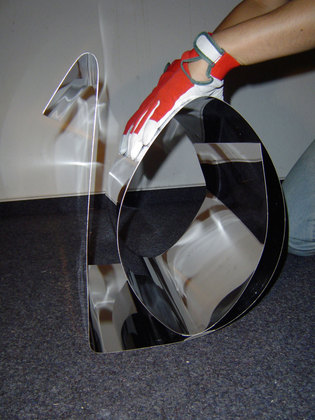 Countdown Performance
, 2007
Countdown Performance
, 2007
The accumulations of found materials in Nora Schultz’s tentative assemblages seem intent on skirting any definitive form or meaning. Leaning, propped, or carefully balanced, they remain always contingent on each other, alternately supporting and being supported. Schultz’s arrangement of objects and the intricate choreography of the relationships between them invites a “reading” of their forms as if they were words or points of punctuation in a sentence, creating an opaque formal vernacular that teases with the possibility of decipherment.
Typically the result of an extended performative process, Schultz’s exhibitions are layered like a palimpsest of gestures and formal manipulations that leave their traces on the surfaces of her assemblages. A series of photographs entitled Countdown Performance (2007) documents a piece of aluminum sheeting being formed and reformed into the numerals 0 to 10. Documentary in their appearance, the photographs literalize the sequential transformation to which Schultz submits her materials. Subjected to yet further adaptation, the piece of aluminum appears in another work entitled Corner Panorama (2007), which consists of a sheet of paper hung in the corner of a room and trailing onto the floor. The aluminum band, which was used as a drawing template for the delicate tracery of pencil lines that weave across the surface of the paper, assumes its final resting place on the floor at the base of the paper’s folds, its zero configuration emphatically marking the end of its transformation.
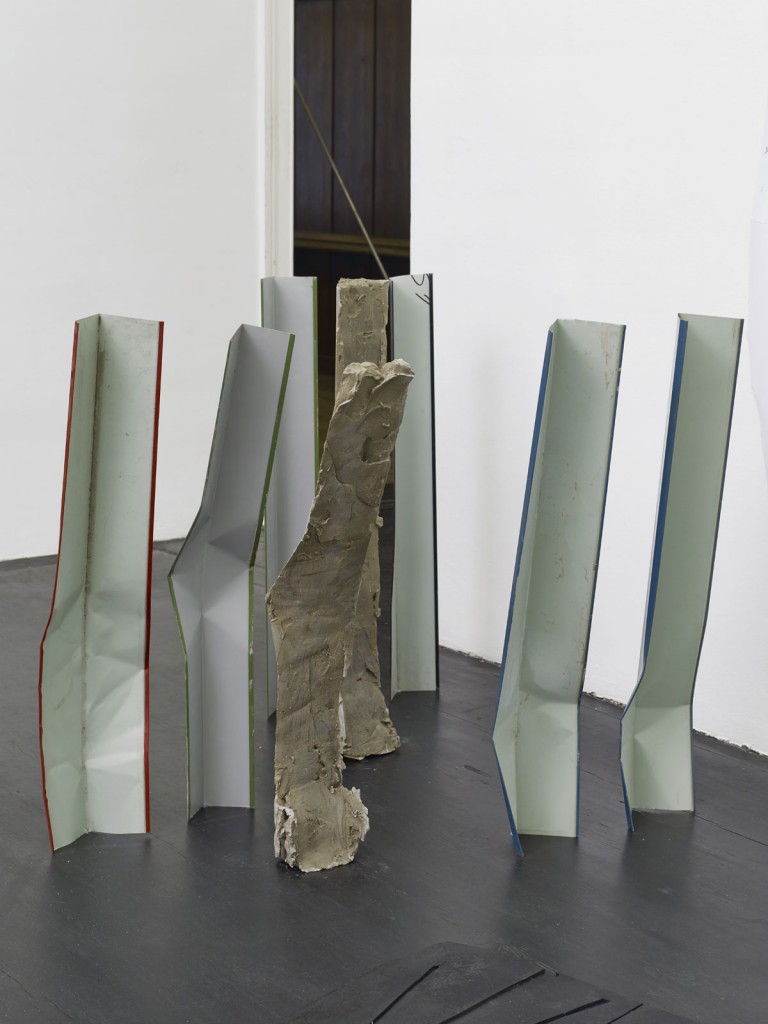 The Tripod's Escape
, 2013
The Tripod's Escape
, 2013
Narrative becomes a slippery tool in Schultz’s hands, stalled by repetition, doubling and an intermittent loss of sense. Block Letters (2007) is part sculpture, part text and encapsulates her interest in the materiality of language and the translation of formal configurations into textual exegesis. Around a delicate metal frame, which leans in the corner of a room for stability, are stretched panels of printed text repeated twice across four armatures. The text describes a couple who attempt to walk around an imposing building but find that the building “walks with them.” Unable to ignore their uninvited companion, they agree to destroy the building. In its form, Block Letters is at once reminiscent of the open pages of a book and a paper architectural maquette, establishing a co-dependent relationship in which the structure and text rely on each other for support and meaning.
For the exhibition “On Interchange” at the Museum Kurhaus Kleve, Schultz constructed an installation that charted a narrative through an elaborate sequence of interconnected references. Dear Parrot (2008) assembled disparate fragments—a multiple-exposure photograph of a pair of parrots, excerpts of a personal and unanswered letter from James Lee Byars to Joseph Beuys, an image of an installation by Lothar Baumgarten previously installed at the museum, a series of documents elucidating historical characters that she discovered in the museum’s archives – into a precarious yet eloquent mise-en-scène. Woven around a central installation of plinths and reams of paper marked with colored lines created in a performance by the residual tangle of metal rods leaning against a nearby wall, the installation was not only an exploration of the gathered motifs and references but also a reflexive investigation into the act of art-making itself. [Andrew Bonacina]
KATJA STRUNZ
Born 1970, Ottweiler, Germany. Lives in Berlin, Germany.
 Brunnen
, 2008
Brunnen
, 2008
Katja Strunz’s work has always played with modernist forms, but her statements over the years have gradually expanded and become more substantial. Many of her early works are fragile, whimsical, even nostalgic, incorporating delicate, found or recycled materials such as yellowed pages torn from old books or discarded metal pieces. In Visionary Fragment (für Antoine Augustin Cournot) (2005), she cast slices of honeycomb in bronze, while her installation Yesterday’s Echoes (2005) consisted of found copper and other bits of antique metal instruments with which she created little mushroom and umbrella shapes that sprouted from the floor. Such works were often directly connected to specific eras or places: titles like Whose Garden Was This? (2005) suggest the passing of time or obsolescence—subjects of particular interest to Strunz, whose studio is located in the former East Berlin. In Brunnen (Fountain, 2000) she introduced into the gallery a set of old copper stairs that she had found in a defunct Berlin swimming pool.
The work in Strunz’s solo show “Einbruchstellen” (Points of Rupture, 2008) represents an even bolder entry into space. The forms seem to have expanded from her previous work, taking on the characteristics of the definitive, even muscular gestures associated with Minimalism. The exhibition was populated with large-scale sculptures of white, black, and pink lacquered wood and steel, which protrude from the wall or rest on the floor. The majority of these are composed of Strunz’s signature forms: triangular shapes created from folds or pleats, which create dynamic angles, shadows, and negative spaces. Strunz transforms creased or crinkled metal into what look like collapsible fans or Japanese screens.
 Einbruchstelle
, 2008
Einbruchstelle
, 2008
These sculptures have a solid, furniture-like presence, though they aren’t rigidly geometric; they also incorporate a sense of unfolding or disassembly. Einbruchstelle (2008), a floor-based steel and wood sculpture, looks like a giant paper plane that has crash-landed into its black podium. Memory Wall (2008), a series of cubes mounted on the wall, resembles an upturned Carl Andre floor piece, one whose squares have been damaged, oxidized, burned, or are slowly drifting away from each other. Standing in front of the sculpture creates a momentary sense of vertigo, as if one is looking down on the tops of skyscrapers.
But Strunz also manages to make her heavy, solid materials defy their weight and take on the grace and lightness of origami figures or ornamental napkins. Her smaller-scale wall sculptures incorporate the same dynamic angles and sharp incisions as her collages, and refer to Russian Constructivist and Suprematist sculptures. They also continue her interest in the idea of time, though more literally—many of them resemble kinetic sculptures or clocks whose hands nonsensically point to folded planes of metal. Some have two mirrored folded sides, as if imitating a butterfly’s wings. Though Strunz’s newest works may be edging toward the monumental, they nevertheless retain a patina of the past, suggesting that the promises of modernism haven’t held up as well as we might have hoped. [ Christy Lange ]











